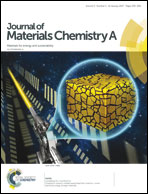A robust design of Ru quantum dot/N-doped holey graphene for efficient Li–O2 batteries†
Abstract
Herein, we report a simple, versatile, defect-engineered method to fabricate Ru quantum dots (Ru QDs) uniformly anchored on a nitrogen-doped holey graphene (NHG) monolith. It uses in situ pyrolysis of mixed glucose, dicyandiamide (DCDA), and RuCl3, followed by an acid treatment, and a final heat treatment to introduce in-plane holes of various sizes. A novel transmission method in scanning electron microscopy was successfully implemented to directly visualize the holes with color contrast. A low accelerating voltage of 5 kV enabled prolonged observation without significant electron beam damage. The mechanisms of hole creation were examined in detail using various characterization techniques as well as control experiments. The Ru QDs had significant catalytic activity and resulted in larger in-plane holes through the graphene sheets. The mechanical strain and the chemical reactivity of Ru QDs significantly diminished the activation energy barrier for the oxidation of C![[double bond, length as m-dash]](https://www.rsc.org/images/entities/char_e001.gif) C bonds in the graphene structure. The Ru QD/NHG hybrid material was utilized as an electrocatalyst for the oxygen evolution reaction in Li–O2 batteries, showing much lower charge overpotentials compared to the bare NHG counterpart. The defect-laden holey graphene counterpart can be highly functionalized for multiple applications, leading to a new method of nanoengineering based on atomic scale defects.
C bonds in the graphene structure. The Ru QD/NHG hybrid material was utilized as an electrocatalyst for the oxygen evolution reaction in Li–O2 batteries, showing much lower charge overpotentials compared to the bare NHG counterpart. The defect-laden holey graphene counterpart can be highly functionalized for multiple applications, leading to a new method of nanoengineering based on atomic scale defects.


 Please wait while we load your content...
Please wait while we load your content...